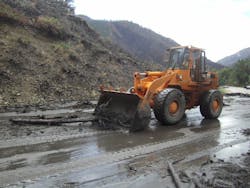Bridges and roads in the northeastern and eastern parts of Colorado washed out by flooding from torrential rains over the past week will hamper trucking operations in the area for some time to come, despite an ongoing “full-press” effort by numerous Colorado agencies to reopen access to numerous communities isolated by severe flooding throughout those regions.
“A lot of these areas experienced a year’s worth of rainfall in just three days; it’s created an unbelievable challenge for our members,” Greg Fulton, president of the Colorado Motor Carriers Association (CMCA), told Fleet Owner. “The only saving grace is that this is not happening during winter, for the amount of rain we’ve seen would translate to roughly 10 or 12 feet of snow.”
Since last week, the Colorado Department of Transportation (CDOT) said it remains focused on rescue efforts in Larimer, Boulder and Weld counties and across the northeastern plains. While the flooding continues in eastern Colorado, the water is subsiding in many areas and CDOT said it is expediting repairs in several areas.
CDOT is also in the process of obtaining three response teams to help construct the temporary roads for U.S. 36 and State Highway 7 between Boulder and Estes Park, U.S. 34 between Loveland and Estes Park, SH 72 between U.S. 93 and SH 119 and for impacted highways in eastern Colorado.
“With winter on our heels, we need to focus on restoring routes to communities that currently have limited access,” said CDOT Executive Director Don Hunt in a statement. “The work will be conducted by CDOT staff, emergency contractors and National Guard where possible to remove debris, make necessary repairs and begin building temporary roads to improve access to as many impacted routes as possible.”
CMCA’s Fulton added that a “window” for hours of service (HOS) waivers remains open as trucking companies find they need travel much longer distances to circumvent flooded areas in order to resupply communities with food, potable water, and other goods.
Currently, CDOT estimates approximately 30 bridges have been destroyed by flooding, with 20 sporting serious damage, while the status of other major roadways and bridges remains unknown.
“It’s making it extremely difficult to get into certain locations, and the secondary roads that are still accessible are not for the faint of heart,” added CMCA’s Fulton. “But the good thing is the major interstates seem intact at this point.”
The Colorado National Guard (CONG) reports that as of yesterday, a total of 754 troops, 19 helicopters, 200 vehicles, plus 20 ground search-and-rescue teams are currently involved in rescue and evacuation operations. Also, nearly 18.5 tons of cargo, including critical food, water and clothing and transportation and engineering supplies have been transported via military helicopters since flood operations began, with 209 CONG members currently manning 67 checkpoints in Fort Collins, Longmont, Greeley, Milliken/Evans, and Boulder, in order to ensure public safety and protect property.
President Barack Obama has also declared a major disaster exists in Colorado and ordered federal aid to supplement state and local recovery efforts in the area affected by severe storms, flooding, landslides and mudslides. The Federal Emergency Management Agency (FEMA) reports that damage surveys are continuing in other areas, and more counties and additional forms of assistance may be designated after the assessments are fully completed.
Yet CMCA’s Fulton cautioned that one of trucking’s biggest challenges in the days and weeks ahead will be hauling oversized loads of gear to help restart many natural gas wells shut down by the flooding.
“If it turns out wells are damaged by all the flooding, it’s going to be really hard to move in the heavy equipment and supplies needed to repair and restart them.” Fulton said. “That’s going to take a while to sort out. CDOT is looking to get things back up and running quickly and there’s been great support from the state and federal government, but there’s no easy silver bullet to solve all of this. It will just take a lot of time.”
About the Author
Sean Kilcarr
Editor in Chief
Sean Kilcarr is a former longtime FleetOwner senior editor who wrote for the publication from 2000 to 2018. He served as editor-in-chief from 2017 to 2018.
